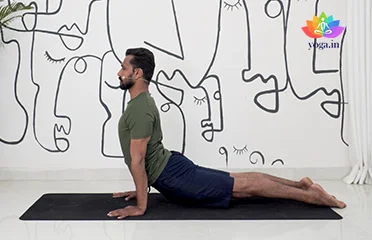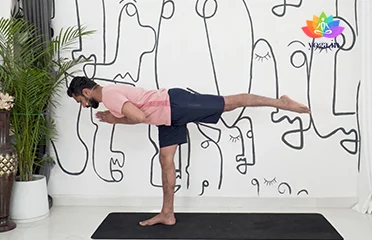Simhasana (Lion Pose)
सिंहासना / Lion Pose
The Sanskrit name is derived from Simha (सिंहा) which means lion and [�K]
Tittibhasana (Firefly Pose)
तिट्टीभासन / Firefly Pose
The Sanskrit name is derived from Tittibha (तिट्टीभा) meaning [�K]
Urdhva Mukha Svanasana (Upward-Facing Do
ऊर्ध्वमुखश्वानासन / Upward-Facing Dog Pose
The Sanskrit name is derived from Urdhva (ऊर्ध्व) meaning up, Mukha [�K]
Utkatasana (Chair Pose)
उत्कटासन / Chair Pose
The Sanskrit name is derived from Utkata (उत्कटा) meaning “powerful” [�K]
Utthita Hastapadangusthasana (Extended H
उत्थिता हस्तपदंगुष्टासना / Extended Hand-To-Big-Toe Pose
The Sanskrit name is derived from Utthita (उत्थित) meaning "extended", [�K]
Vasishtasana (Side Plank Pose)
वसिष्ठासन / Side Plank Pose
The Sanskrit name is derived from Vasistha (वसिष्ठा) meaning wealthy [�K]
Virabhadrasana III (Warrior Pose 3)
विरभद्रासन III / Warrior Pose 3
The Sanskrit name is derived from Vira (विरा) meaning hero, Bhadra (भद्रा [�K]
- 1
- 2
- 3
Strengthening and Toning – Yoga for Arms and Abdominal Organs
Yoga offers a holistic approach to fitness, and while it doesn’t directly target internal organs, it can strengthen and tone the muscles surrounding them, including those in the arms and abdomen. This, in turn, can lead to several benefits for overall health and well-being.
Important Disclaimer – Yoga is not a substitute for medical treatment. If you have any concerns about your abdominal organs, consult a healthcare professional.
Yoga for Arms and Abdominal Organs
While yoga poses don’t directly manipulate internal organs, the improved circulation they promote can be beneficial for the abdominal region. Increased blood flow delivers essential nutrients and oxygen to the digestive organs, potentially aiding in digestion and nutrient absorption. Additionally, improved circulation helps remove waste products from the body, which can contribute to a healthier digestive system overall. It’s important to remember that yoga is a complementary practice, and maintaining a healthy diet with adequate fiber and hydration remains crucial for optimal abdominal health.
Benefits of Yoga for Arms and Core –
- Improved Strength and Tone: Certain yoga poses target the muscles in the arms and core, leading to increased strength and definition. This can improve posture, stability, and daily activities.
- Enhanced Flexibility: Yoga stretches and lengthens muscles, improving overall flexibility. This can benefit daily life and reduce the risk of injuries.
- Increased Core Stability: A strong core provides support for the spine and helps with balance and coordination. Many yoga poses engage the core muscles, promoting stability.
- Improved Circulation: Yoga can enhance blood flow throughout the body, which can benefit the digestive system and other internal organs indirectly.
- Stress Management: Yoga’s focus on mindful movement and breathing can help reduce stress, which might positively impact overall health.
Remember –
- Listen to Your Body: Modify poses to suit your individual needs and comfort level.
- Start Slowly: If you’re new to yoga, begin with beginner-friendly poses and gradually progress.
- Seek Guidance: Consider practicing with a qualified yoga instructor who can guide you safely and offer modifications based on your abilities.
Yoga and Internal Organs –
While yoga poses don’t directly target internal organs like the stomach or intestines, the benefits mentioned above can contribute to overall well-being and potentially aid in digestion. Remember, a healthy lifestyle with a balanced diet and regular exercise is crucial for optimal abdominal health. Yoga can be a valuable tool for strengthening and toning the muscles surrounding the arms and abdominal organs. This, in turn, can lead to improved posture, strength, flexibility, and potentially contribute to better overall health. Always prioritize professional medical advice and listen to your body when practicing yoga.








